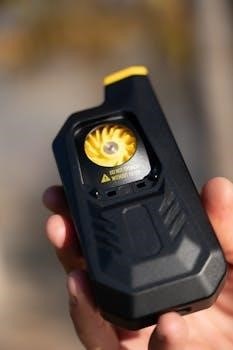The Yamaha Sun Classic golf cart, a notable model from the 1980s, exemplifies enduring vintage design and performance. Its popularity continues, making original owner manuals vital for preservation and operation.
The Enduring Appeal of Vintage Golf Carts
Vintage golf carts, like the 1980s Yamaha Sun Classic, hold a special charm for many enthusiasts. These classic carts offer a unique blend of nostalgia and functionality. Their simple designs and robust construction make them appealing to those who appreciate the craftsmanship of older vehicles. Owners often enjoy the process of maintaining and restoring these timeless machines, ensuring their continued use for years to come. The community surrounding vintage carts adds to their overall allure;
Importance of Owner Manuals for Maintenance
Owner manuals are crucial for maintaining vintage golf carts, like the Yamaha Sun Classic. They provide essential information for proper care, ensuring reliable performance and longevity.
Following Maintenance Schedules in the Manual
Adhering to the maintenance schedules detailed in your Yamaha Sun Classic owner’s manual is essential for optimal performance. These schedules outline specific tasks and intervals, ensuring your vintage gas-powered golf cart remains reliable. Regular checks and timely maintenance, as directed by the manual, can help prevent potential issues and extend the lifespan of your cart. This proactive approach ensures years of enjoyment.
Ensuring Reliable Performance of Vintage Models
Maintaining the reliability of a vintage golf cart like the 1980s Yamaha Sun Classic requires diligent care, as outlined in the owner’s manual. Proper adherence to the recommended maintenance procedures is vital for preventing breakdowns and ensuring consistent performance. The manual provides detailed instructions that enable owners to keep these classic carts running smoothly. This dedication helps preserve their legacy and functionality.
Locating 1980s Yamaha Sun Classic Owner Manuals
Finding original owner’s manuals for the 1980s Yamaha Sun Classic golf carts can be challenging. However, digital PDF versions are often available, offering a convenient alternative for owners.
Challenges in Finding Original Manuals
The age of the 1980s Yamaha Sun Classic golf carts presents a significant hurdle in locating original paper manuals. These documents, due to their age, are often lost, damaged, or simply unavailable. Many owners struggle to find intact, authentic versions, making the search a considerable challenge for those seeking original documentation for their vintage carts.
Availability of Digital PDF Versions
Fortunately, digital PDF versions of the Yamaha Sun Classic golf cart owner manuals are increasingly accessible online. These digital formats offer a convenient alternative to scarce original paper copies. Owners can often find these PDFs on various online forums, enthusiast websites, or through dedicated golf cart manual repositories, making the information more readily available for download and use.
Content of Yamaha Golf Cart Owner Manuals
Yamaha golf cart owner manuals typically include crucial information such as operation instructions, maintenance guidelines, and troubleshooting tips. These manuals serve as essential resources for owners.
Operation Instructions
The operation instructions section in a Yamaha golf cart owner’s manual provides detailed steps for starting, driving, and stopping the vehicle. It includes information on using the accelerator, brake pedals, and other controls. This section is crucial for new owners to familiarize themselves with the correct and safe operation of the golf cart, ensuring proper handling and avoiding potential accidents.
Maintenance and Care Guidelines
The maintenance and care guidelines section of the owner’s manual outlines essential procedures for preserving the golf cart’s condition. This includes instructions on regular checks, lubrication, cleaning, and specific maintenance tasks. Following these guidelines helps ensure the longevity and reliable operation of the vintage Yamaha Sun Classic. Proper maintenance is crucial for avoiding costly repairs and keeping the cart in optimal condition.
Troubleshooting Common Issues
This section provides solutions for typical problems encountered with the vintage Yamaha Sun Classic golf cart. The manual will include diagnostic steps and repair advice for issues like engine troubles, starting difficulties, or unusual noises. Having a troubleshooting guide is essential for quick fixes and helps owners understand the common problems, enabling them to maintain their cart effectively. This section will be very useful for owners.

Specific Manuals for Yamaha G5 Sun Classic
For the Yamaha G5 Sun Classic model, locating both the factory repair manual and the original owner’s manual is crucial for proper maintenance and care of the vehicle.
Finding the G5 Factory Repair Manual
Securing a factory repair manual for the Yamaha G5 Sun Classic can be challenging, as these are often not widely available. Enthusiasts and owners may need to explore online forums, vintage golf cart communities, and specialized parts suppliers to locate a copy, either in physical or digital PDF format. Such a manual is essential for detailed repairs.
Original Owner’s Manual for G5
Locating the original owner’s manual for the Yamaha G5 Sun Classic is crucial for proper operation and maintenance. This manual contains specific instructions, safety precautions, and vehicle details. It is a primary source for understanding the cart’s features and ensuring safe use. Owners should seek out online versions, potentially found on forums or dedicated manual sites, as physical copies may be scarce.

Copyright and Usage of Online Manuals
Yamaha retains copyrights for online owner’s manuals. Copying, modifying, or distributing these manuals is prohibited. It’s important to use official Yamaha sources to ensure accuracy and avoid legal issues.
Restrictions on Copying and Modifying Manuals
Online Yamaha owner’s manuals are protected by copyright and intellectual property rights. Users are strictly prohibited from copying, modifying, or distributing any part of these manuals. These restrictions are in place to protect Yamaha’s ownership and ensure the integrity of the information provided. Unauthorized usage may result in legal consequences, as Yamaha maintains control over its intellectual assets. Respecting these copyright terms is essential for accessing and using these manuals.
Importance of Official Yamaha Sources
Relying on official Yamaha sources for owner’s manuals is crucial to ensure accuracy and avoid misinformation. Manuals from unofficial sources might contain errors or be for different models. Using official Yamaha manuals safeguards your golf cart and protects your investment. Official manuals also provide the most relevant and updated information. Always use genuine Yamaha manuals to maintain the cart’s performance and lifespan.

Key Information in Owner Manuals
Owner’s manuals contain crucial data including vehicle identification, serial numbers, and essential safety precautions. These details are vital for proper maintenance and safe operation of the golf cart.
Vehicle Identification and Serial Numbers
The frame serial number, serving as the primary identification, is typically located on the rectangular pipe beneath the operator’s seat. This number is crucial for identifying the specific model and year of your Yamaha Sun Classic golf cart. Knowing the exact serial number is essential when ordering parts or seeking technical support and also useful for verifying the authenticity of the vehicle.
Safety Precautions and Warnings
When working on the battery of your Yamaha Sun Classic, it is essential to avoid any open flames, sparks, or smoking near the vehicle to prevent potential fires or explosions. Always disconnect the battery before performing any maintenance or repairs. These precautions are crucial to ensure your safety and the proper functioning of the golf cart, as well as the prevention of accidents and damage.
Specific Information in Owners Manual
Owner’s manuals for the Yamaha Sun Classic provide detailed specifications, including transmission information. They also outline periodic inspection and adjustment procedures crucial for maintaining the cart’s performance.
Transmission Specifications
The owner’s manual for the 1980s Yamaha Sun Classic golf cart provides crucial transmission specifications, detailing the type of transmission used in the vehicle. This section clarifies gear ratios, fluid types, and maintenance guidelines specific to the cart’s transmission system. Understanding these specifications is essential for proper care and to ensure the smooth operation and longevity of your vintage golf cart.
Periodic Inspection and Adjustment
The owner’s manual emphasizes the importance of periodic inspection and adjustment for your Yamaha Sun Classic golf cart. This section outlines the specific components that require regular checks, such as brakes, tires, and steering mechanisms. Following the manual’s guidelines on these inspections and necessary adjustments helps maintain optimal performance, ensuring the safety and reliability of your vintage cart during operation.
Additional Resources for Yamaha Golf Cart Owners
Owners can find help through the official Yamaha Golf Car Manuals site. Online forums and communities also offer valuable support, information, and shared experiences.
Yamaha Golf Car Manuals Site
The official Yamaha Golf Car Owners Manual site is a crucial resource, offering genuine manuals to help protect your investment. These manuals are specifically for United States models, and they are available exclusively in English, ensuring accuracy and reliability. Avoid unofficial sources and rely on Yamaha’s official materials for proper guidance. This is your go-to place for the most reliable manuals.
Online Forums and Communities
Online forums and communities serve as valuable platforms for Yamaha golf cart owners to connect, share experiences, and offer assistance. These spaces often host discussions on locating manuals, troubleshooting issues, and general maintenance tips. They provide a collaborative environment where owners can benefit from collective knowledge and advice, enhancing their understanding of their vintage Yamaha golf carts. This is a great place to get specific questions answered.

Troubleshooting and Safety
Safety is paramount when maintaining a vintage golf cart. Always avoid sparks and open flames near the battery. Refer to your owner’s manual for essential safety guidance.
Safety Precautions when working with the battery
When handling the battery of your 1980s Yamaha Sun Classic golf cart, utmost caution is necessary. Never smoke or allow any sparks or open flames near the vehicle to prevent potential fires or explosions. It is imperative to disconnect the battery before commencing any work. Always refer to the safety guidelines in your owner’s manual for comprehensive instructions.
Operating and maintaining the cart
To ensure the longevity and optimal performance of your vintage Yamaha Sun Classic, it is critical to operate and maintain the golf cart as directed by the owner’s manual. This includes following specified maintenance schedules, using appropriate fluids, and adhering to the operational guidelines. Regular inspection and prompt addressing of any issues contribute to a safe and enjoyable experience.




















